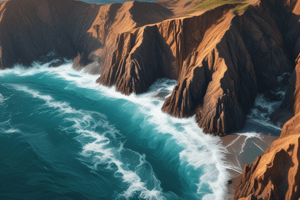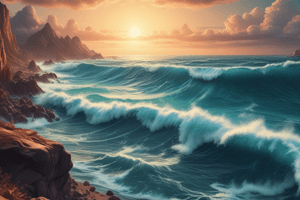Podcast
Questions and Answers
What technology did scientists use in the late 1940s to determine the depth of the ocean?
What technology did scientists use in the late 1940s to determine the depth of the ocean?
- Radar
- Submarines
- Sonar
- Echo sounder (correct)
Mid-ocean ridges are shorter than mountain ranges found on land.
Mid-ocean ridges are shorter than mountain ranges found on land.
False (B)
What is the name given to erupted magma on Earth's surface?
What is the name given to erupted magma on Earth's surface?
lava
The process by which new oceanic crust forms along a mid-ocean ridge is called seafloor ________.
The process by which new oceanic crust forms along a mid-ocean ridge is called seafloor ________.
Match the following terms with their descriptions:
Match the following terms with their descriptions:
What happens to the age of oceanic crust as you move farther away from a mid-ocean ridge?
What happens to the age of oceanic crust as you move farther away from a mid-ocean ridge?
Continents move through the solid mantle during seafloor spreading.
Continents move through the solid mantle during seafloor spreading.
What is the name of the instrument used to measure the magnetic signature of rocks?
What is the name of the instrument used to measure the magnetic signature of rocks?
The state in which magnetized objects orient themselves to point south is called _______ polarity.
The state in which magnetized objects orient themselves to point south is called _______ polarity.
During which polarity state does a compass needle point towards the north?
During which polarity state does a compass needle point towards the north?
Magnetic reversals occur every few years.
Magnetic reversals occur every few years.
What type of minerals found in basalt on the seafloor are used to determine magnetic signatures?
What type of minerals found in basalt on the seafloor are used to determine magnetic signatures?
Parallel _______ stripes on either side of mid-ocean ridges provide evidence for seafloor spreading.
Parallel _______ stripes on either side of mid-ocean ridges provide evidence for seafloor spreading.
Besides magnetic signatures, what other evidence supports the theory of seafloor spreading?
Besides magnetic signatures, what other evidence supports the theory of seafloor spreading?
Sediment thickness decreases with distance away from a mid-ocean ridge.
Sediment thickness decreases with distance away from a mid-ocean ridge.
Flashcards
Mid-ocean ridges
Mid-ocean ridges
Mountain ranges in the middle of the oceans, significantly longer than mountain ranges on land.
Seafloor Spreading
Seafloor Spreading
Process where new oceanic crust forms at a mid-ocean ridge and older crust moves away from the ridge.
Lava
Lava
Molten rock that erupts on Earth's surface.
Pillow lavas
Pillow lavas
Signup and view all the flashcards
Abyssal plain
Abyssal plain
Signup and view all the flashcards
Normal polarity
Normal polarity
Signup and view all the flashcards
Reversed polarity
Reversed polarity
Signup and view all the flashcards
Magnetometer
Magnetometer
Signup and view all the flashcards
Study Notes
- In the late 1940s, scientists explored the seafloor in detail using echo sounders to determine ocean depth.
- These depth data were used to create topographic maps of the seafloor, revealing vast mountain ranges called mid-ocean ridges.
- Mid-ocean ridges are longer than any mountain range found on land.
Seafloor Spreading
- Seafloor spreading explains continental drift and involves new oceanic crust forming at mid-ocean ridges while older crust moves away.
- As the seafloor spreads, the mantle melts and forms magma, which rises through cracks in the crust along the mid-ocean ridge.
- When magma erupts, it is called lava, which cools and crystallizes into basalt, forming rounded pillow lavas.
- The closer the oceanic crust is to a mid-ocean ridge, the younger it is, and as the seafloor continues to spread apart, the older oceanic crust moves progressively away from the ridge.
- Seafloor spreading provided the mechanism to explain continental drift.
- Mid-ocean ridges form either through lava eruptions that cool and build up around the ridge or through cracking and movement of rocks along the seafloor.
- Sediment accumulates on top of the oceanic crust, with almost no sediment near the mid-ocean ridge.
- Far from the ridge, sediment becomes thick enough to create the abyssal plain.
- Continents move as the seafloor spreads along mid-ocean ridges.
Magnetic Reversals
- Earth's magnetic field, created by the iron-rich liquid outer core, experiences changes in direction.
- Normal polarity is when magnetized objects point north, while reversed polarity is when they point south.
- Magnetic reversals occur every few hundred thousand to few million years.
- Basalt on the seafloor contains iron-rich magnetic minerals that align with Earth's magnetic field when lava cools and crystallizes, recording the field's direction at the time.
- Parallel patterns in the magnetic signature of rocks on either side of mid-ocean ridges have been discovered.
- Scientists measured the magnetic signature of rocks using a magnetometer, revealing parallel magnetic stripes, with each pair having similar composition, age, and magnetic character.
- Each stripe represents crust formed and magnetized at a mid-ocean ridge during normal or reversed polarity.
- Magnetic stripes confirm that ocean crust forms at mid-ocean ridges and is carried away in opposite directions.
Other Evidence
- Measurements of thermal energy leaving Earth show more energy released near mid-ocean ridges than from abyssal plains.
- Sediment dating reveals that sediment closest to the mid-ocean ridge is younger, and sediment thickness increases with distance from the ridge.
Studying That Suits You
Use AI to generate personalized quizzes and flashcards to suit your learning preferences.




